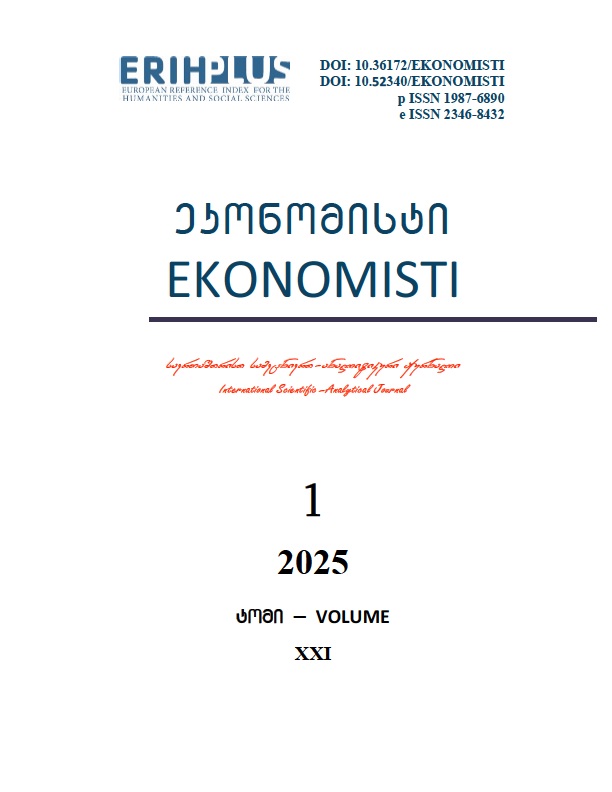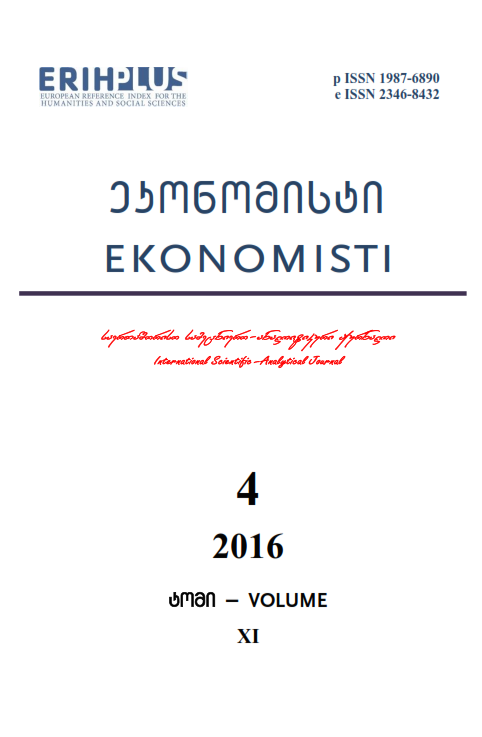
The international scientific and analytical, reviewed, printing and electronic journal of Paata Gugushvili Institute of Economics of Ivane Javakhishvili Tbilisi State University

This article discusses on the example of Georgia the influence of monetary impulses towards the real GDPand real sector of economy
Expanded Summary
This article discusses on the example of Georgia the influence of monetary impulses towards the real GDPand real sector of economy. For this purpose, under the vector autoregressive model has been carried out the reaction functions’ study on the impulse. The survey shows that the money supply stock's impact on the real estate price index is important. The above-mentioned fully responds to the the idea of economic theory of money supply stimulation on the economy in the short term, and the real estate market is no exception also.
Introduction: It should be noted that in 1996-2015 in a Georgia the circulation of the national currency's volume was approx. 13-times more increased, while the average annual growth rate reached approx. 16%. Money supply rate was especially high in the years 2004- 2007.Against this background the real GDP 2.7 times increased, according to official statistics, and the consumer price index has increased 2.8 times, average annual real GDP growth rate was 5.8%, while the average annual inflation reached about 6%.Difficulties of the monetary policy were related to the large number of inflows of the foreign currency ,namely according to the Georgian Tax Balance's financial account the extent of the foreign investments amounted up to only 8.5 billion US dollars during the years 2002-2008, while the National Bank's foreign currency reserves increased by $ 1,372 million.
Data and econometric model: during the research process it is used two types of model. The key reason for the separation of models is the lack of the number of observations in the key variables separation of variables. The first model includes the quarterly figures for 2007-2015[1] , and the second model includes quarterly 2009-2015 indicators. The study is based on the examination of reactions of functions based on the vector auto regression model:
The first model:

The second model:

Whereas, Yt- the endogenous variables vector, Zt-exogenous vector variables, Et-residual member vector.
For Endogenous variables were used the following timelines[2]: Real Gross Domestic Product (GDP); The consumer price index (CPI); The national currency loans, the average real interest rates in the quarter (R); Real effective exchange rate (REER); Household consumption in real chart (RC)[3]; Real estate price index 3 (AP); Government securities interest rates (GR), In order to describe the money supply indicator we have used the three parameters : Reserve money (CC); Monetary aggregate (M3), the monetary aggregate (M2)As an Exogenous variables have been used received abroad in the natural form (current and capital) transfers (Y_tr) and the factor income received from abroad in (Y_f) the sum of (TR), the figure was used in the sense that from our point of view this variable mostly was the determinant of the national economic conjuncture for the evaluation period , also it is the most exogenous factor and important feature of an external shocks.
Conclusion:
Thus, this article carried out by us revealed the following findings:money supply shock in government securities interest rates did not significantly affect and we can talk regarding its importance only for the short term , but for the medium and long term an impact of the money supply shock is limited.
According the study/survey it is also shown that the importance of the money amount shock on the real estate price index has a great impact. The above-mentioned fully reflects an opinion existing in the theory of economic related the stimulation of economic by the money supply in the short term, where the real estate market is no exception to.
Yours Sincerely,The study also showed that monetary shocks on the real estate price index are stronger than the monetary shocks’ impact on the total output that can be interpreted in a Georgia as the high level inclination of Investment in the real estate market than in the other sectors of the economy, that is due to the underdevelopment of financial markets and institutional restriction.
It should be noted that the difference between the first and second model results are significant, however, reason for this is the inferiority of models. We think that the second model gives a more complete information in terms of the influence of money market towards the real estate price index. Therefore, we can conclude that the growth of monetary aggregates at the initial stage significantly increases the Real estate price index, however, a shock for a long period is the reason of dynamic instability at the the real estate market.
[1]statistics used in the present research is based on of the Ministry of Finance (www.mof.gov.ge); National Bank of Georgia (www.nbg.ge) and the National Statistics Office (www.geostat.ge) data
[2]To make the above figures comparable during the interval of the time, it is important to take into the consideration of the price level, as one of the important factors. Irreducibility of variations in price levels may produce a wrong correlation between the indicators , and as the result of the above-mentioned it is reasonable the adjustment of the parameters for the baseline period (I quarter of 1996)using an overall internal product deflator
[3]Households and households serving private non-profit organizations and their expenditures’ ultimate consumption at the final upper-real picture/chart

